Wind
In the world of the offshore wind turbine, size matters. Offshore turbines have always been larger than their land-based counterparts, but in recent years they’ve sprung up faster than a teenager in
a growth spurt. From the 3.6MW turbines that were state of the art around 10 years ago, the current installations at offshore windfarms under construction are 8MW units; to give a size comparison, the rotor on a 3.6MW turbine is about the size of the London Eye with the top of the uppermost blade 120m above sea level when it’s vertical, while an 8MW turbine is 222m from sea level to blade tip.
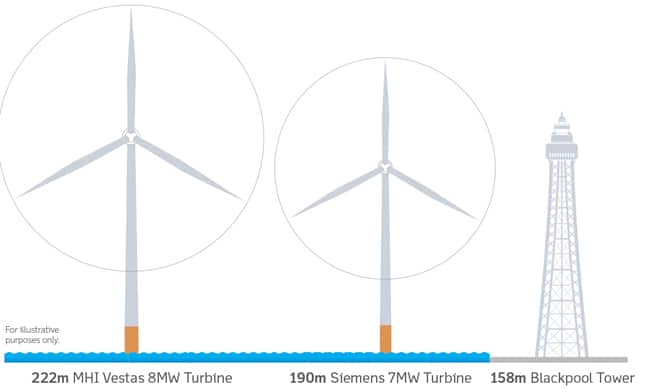
The reason is cost. It’s much windier out at sea than on land, even on the windiest day, and the larger the area swept out by the rotating blades, the more of that wind resource the turbine can capture. But cost comes into play because, although large turbines are of course more expensive then smaller ones, the costs for the entire installation don’t rise in a linear fashion. Large generators are cheaper per unit of torque than smaller ones, and the cost for the foundations, infrastructure and installation of a large turbine aren’t much higher than a smaller one. The feeling in the industry is that if you go to the expense of putting in the foundations for an offshore turbine and all the cabling, then it makes sense to put the biggest turbine you can on top of it to justify that outlay, said Tim Camp, head of turbine engineering at DNV GL, a Norwegian shipping organisation that has now branched out into renewable energy. The smaller the number of turbines a company needs to make up the generating capacity of a windfarm, the more cost-effective it’ll be and the lower the resulting cost of power: a very important consideration, as offshore wind is still the most expensive way we have of generating electricity. “We’re already talking to people about 10MW turbines and even bigger,” said Brent Cheshire, head of UK operations for DONG Energy, the Danish company that has built and operates most of the UK’s largest offshore windfarms, and is now installing Vestas’s MHI 8MW units at its windfarm extension projects at Walney, off Barrow-in-Furness, and Burbo Bank, in Liverpool Bay. “These really are very big beasts, but they genuinely do drive the cost down.”
There will be a limit to how much bigger offshore turbines can get. The power a wind turbine can produce is proportional to the square of its linear dimensions, whereas its cost is proportional to the cube; so eventually, the cost of getting bigger will outweigh the increased generation benefit. But the feeling in the wind industry is that the industry is still some way off that, so for the next decade at least turbines will continue to get bigger.
The next goal for the sector is the 10MW turbine, as Cheshire said, and although the engineering task of building these giants is by no means trivial (the blades would be the largest composite structure ever made, much larger even than the wings of the biggest passenger aircraft; and gravity loads, experienced when the blade is not in a vertical position, lead to a need to stiffen the blade to prevent bending, which increases weight) some industry figures, notably Siemens Wind Power’s chief technology officer Henrik Stiesdal, think they could be made with current technologies, although DNV’s Camp thinks that bearings and main casings are potentially problematic, and that the industry needs more experience with 6 and 8MW units.
The first plans for a commercial 10MW turbine were unveiled in 2012 by a Norwegian firm, Sway Turbines. Often at the forefront of offshore turbine development, Sway pioneered a concept for floating wind turbines that were anchored to the seabed by a cable.
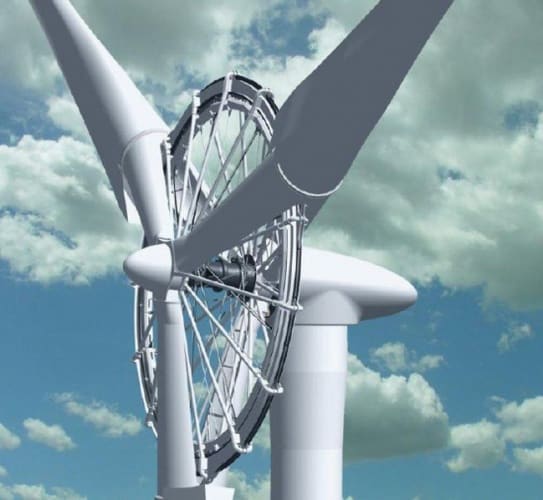
The Sway 10MW concept looks markedly different from a standard turbine; its most distinctive feature is a 25m-diameter open structure, resembling a bicycle wheel, around the hub of its 164m-diameter rotor. This is an open generator, with two rotors sandwiching an iron-free stator, all encapsulated in the rim of the wheel; eschewing iron cuts the weight of the generator (it weighs 162 tonnes compared with 375 tonnes for a conventional direct-drive 10MW generator) and allows cheaper permanent magnets to be used in the rotors, reducing the need for scarce and expensive rare earth metals.
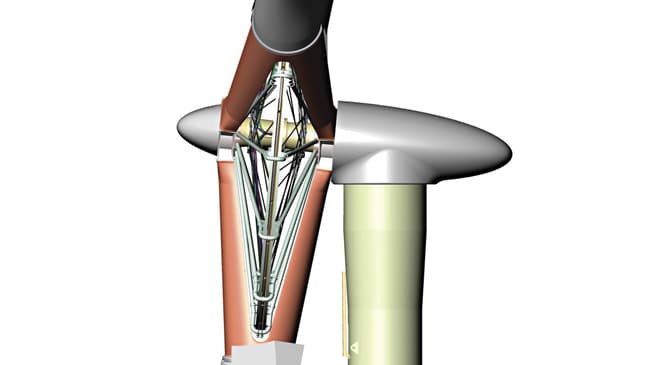
The blades are attached to V-shaped blade support structures, which run from the hub to the generator rim, which adds stiffness and stability to the overall unit, according to chief technical officer Eystein Borgen. The blades are attached directly to the generator rotors through these support structures. This has two main benefits, Borgen explained: “The direct coupling… gives a short load path and leaves the generator air gap unaffected by flapping forward and backward wind loads. Another benefit is the rotor torque and blade gravity loads are distributed and absorbed by the entire structure.”
Solar
One technology has completely dominated the solar photovoltaic sector for almost its entire existence: crystalline silicon. Silicon is extremely abundant and its raw material is very cheap; moreover, silicon’s semiconductor properties are fairly easy to exploit in a form that captures the energy of sunlight and converts it into electric current. Moreover, it’s the most efficient material at doing this.
But although the processes to make crystalline silicon solar panels are well understood, it’s an exacting and expensive business, involving high temperatures and energy usage. Costs have come down in recent years, but this has mainly resulted from economies of scale; and there’s a limit to how much can be gained from this.
There is much research going on into alternatives to silicon, but efficiencies for, as an example, organic photovoltaics have not yet approached silicon. However, one particular class of new materials
is causing excitement. Called perovskites, these materials have achieved large increases in efficiency in a relatively short time; and most exciting of all is that they could be very much cheaper than crystalline silicon; it’s sometimes said they could be more than a thousand times cheaper.
Defining a perovskite is rather tricky. Perovskite itself is a rather unpromising-looking naturally occurring mineral, calcium titanium oxide. But it has lent its name to any substances that have its distinctive structure. They have the general formula ABX3, where A and B are positively charged ions — often metals — of markedly different size, with A bigger than B, and X is a negatively charged ion that binds to both. The structure has the A ion surrounded by 12 X groups at the vertices of a geometrical solid called a cuboctahedron; and the B ion is surrounded by eight X groups at the vertices of an octahedron (two square-based pyramids joined at the base). To avoid confusion, we’ll refer to the former as perovskite mineral and the latter as perovskite structures.
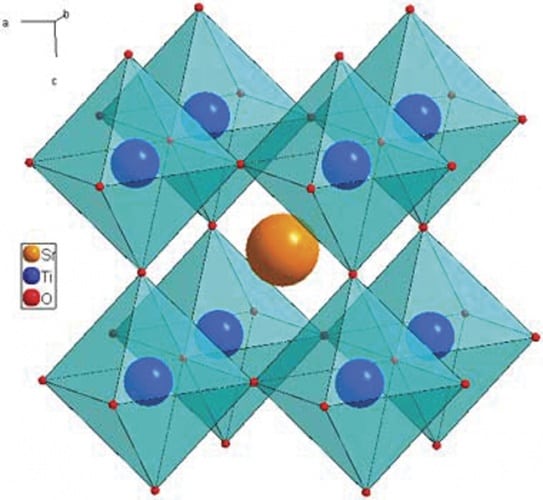
The exciting thing about perovskite structures is how the behaviour of electrons in the material can be tailored. PV cells work by exploiting the phenomenon that high-energy ultraviolet waves can knock electrons loose in semiconductor materials and allow them to move through the material. The energy difference between bound electrons and conducting electrons is known as the band gap and,
in silicon, it matches the energy of the incident radiation. It’s bigger in perovskite structures, but researchers at Los Alamos National Laboratory have found a way to grow perovskite crystals with large areas of high purity; something that is very difficult to do with silicon. In silicon, conducting electrons can easily get trapped at the boundary between a perfect crystal region and a defect, which reduces the efficiency of the material because trapped electrons can’t contribute to the current flow. “We’re growing crystals with millimetre-scale, defect-free domains,” explained Los Alamos researcher Aditya Mohite. In a PV panel, the layer of active material is typically about 500nm thick, which means that it’s extremely unlikely that a photoelectron would ever become trapped. “It virtually guarantees that the photoelectrons make it out,” Mohite said. This advantage outweighs the drawback of the wider band gap, along with one other exciting factor.
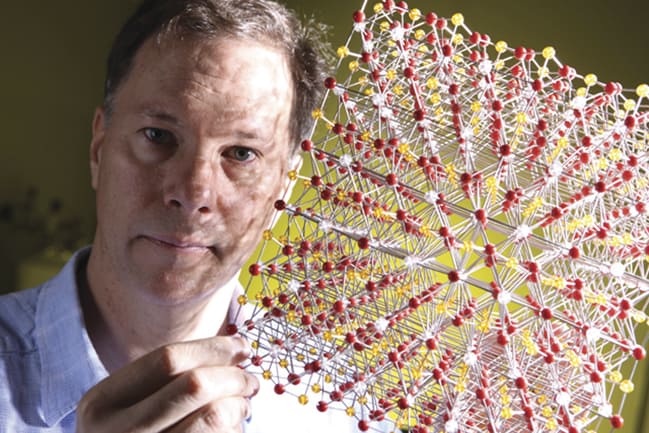
This is that the process to make these high-purity crystals requires low energy. It’s called hot-casting, and involves immersing a hot substrate in a solution of a perovskite structure salt. Even though
it’s a hot process, it’s much cooler than the temperature needed for purifying silicon. Moreover, solution processing is simple, fast and easily scalable for industrial producers, and unlike silicon crystals, doesn’t need clean rooms.
The Los Alamos perovskites, which are based on the compound CH3NH3PbX (where X is a halide) are producing efficiencies around 15 per cent (that is, they convert 15 per cent of the energy in sunlight into usable current) with a peak efficiency so far of 18 per cent. This is still lower than the 20 per cent record for commercial silicon cells, but one thing that gives the researchers hope is that it took decades to develop silicon cells with that efficiency, while perovskite research has only been going on in earnest for a few years. Mohite’s team believes that there are several factors that could be optimised, including the material composition itself, the parameters of the hot casting process and the electrode materials.
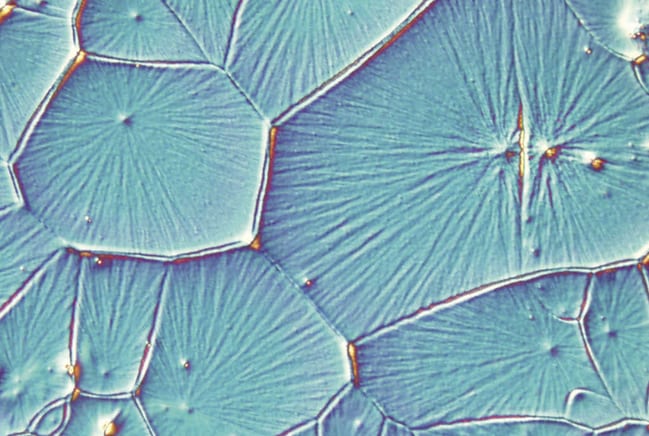
A study by Northwestern University and the US Department of Energy published in August found that perovskite PV cells could repay their costs 10 times faster than silicon PV cells, with a payback time
of about two to three months.
The main drawback still to be overcome with perovskites is their durability. Because the materials usually contain a component that is organic, they degrade in contact with oxygen and humidity so they need to be sealed within shielding materials that tend to reduce the amount of energy that gets to the active material. This is a problem that is also being tackled in the UK, with a team at Imperial College looking at the degradation mechanisms. Led by Saif Haque in the chemistry department, the team has found that when an electron is released from the perovskite crystal, it can react with oxygen in the air, creating highly reactive ‘superoxides’ that attack the crystal, in turn generating water molecules, which also attack the material. Adding a layer of a material such as titanium dioxide, which can trap electrons in the perovskite rather than allowing them to reach the air, could slow this process down or eliminate it altogether, it suggests.
Tidal
Tidal power is the youngest and probably least developed of the three main subsets of renewable energy, but it’s already acquired a recognisable form: something like a horizontal axis wind turbine,
but installed on a framework that allows it to be immersed in the sea. Sometimes the rotor is open, sometimes within a housing or duct; sometimes it’s at the bottom of a shaft that descends from a floating structure on the surface; sometimes it’s in some sort of framework that is anchored onto the seabed; yet another form is embedded into a harbour wall or similar structure that sits across the flow of the tide. But in all cases the turbine is in a sturdy piece of engineering that allows it to remain still in relatively deep water in an area where the tides rip through with high water speeds.
This is one reason that tidal power is so difficult. Areas with tides fast enough for power generation are relatively scarce, depending on the presence of some kind of channel between bodies of water that drain into each other (the Orkney Islands are located at just such a point, where the North Atlantic meets the North Sea, and the channels between islands and between the islands and the north coast of Scotland are well suited, which is why the European Marine Energy Centre is located there). Moreover, fast-flowing water is a very difficult environment to operate in, which makes installing and maintaining the turbines a challenging and expensive business.
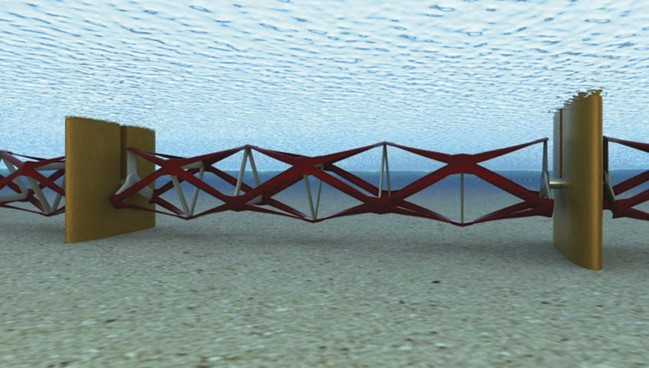
But a new technology called a tidal fence might change the look, location and engineering surrounding tidal energy considerably. Designed to be installed in much shallower and slower water than conventional tidal turbines, tidal fences would represent a cheaper, more accessible alternative that could be used in a tidal estuaries – a far more common location than the fast tide sites needed for other systems.
Tidal fence turbines look rather different from conventional tidal systems. Rather than using a propeller-shaped rotor that sits at right angles to the direction of water flow, they are more like vertical-axis wind turbines laid on their side: barrel-shaped constructions that rotate as the tidal flow runs over and through them. Technically, they are referred to as transverse-horizontal axis water turbines (THAWTs), and they are at their most efficient in shallow water, 20m deep, rather than the 30m depth typically needed for conventional tidal turbines, and in water flowing at about 2-3m/sec, rather than 8-9m/sec as seen regularly off Orkney.
The turbines themselves are made from composites, and have the form of a triangular stressed truss. This has the advantage of not needing to be enclosed in any sort of supporting structure; it just rotates freely between two ‘posts’, which house the generators and export equipment. The basic generating unit consists of two turbines with a central direct drive generator, with four supporting bearings and three foundation supports.
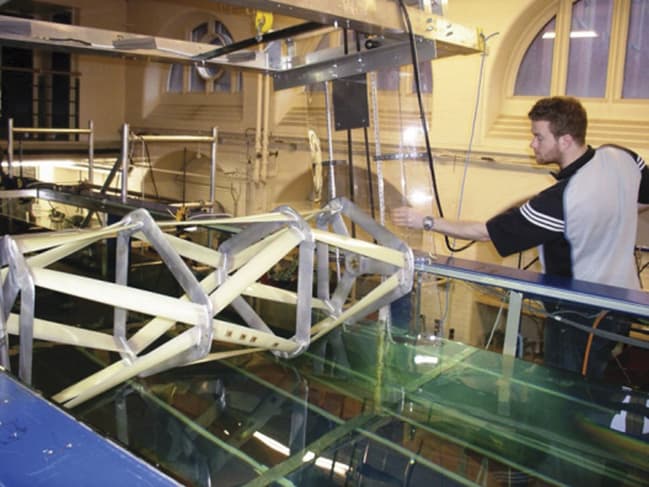
The turbines are being developed by a company called Kepler Energy, which was set up in 2010 to develop technology invented by three researchers from the University of Oxford’s Department of Engineering Science, Ross McAdam, Guy Houlsby and Martin Oldfield, who collaborate with the company on development and testing.
They have tested scale-model turbines in controlled conditions. The simplified structure reduces the cost of the technology considerably, Kepler chairman Peter Dixon told The Engineer. “They need very little maintenance and work in either direction, on the in- and out-tide,” he said. A typical installation for a single unit would be 10m in diameter and 120m long, consisting of two rotors with a single generator; in a 2m/sec flow this would generate more than 4.4MW, and in 2.5m/sec this would rise to above 5.2MW. “The rotation speed is slow, so marine life would be able to swim straight through the turbine without injury, or just avoid them altogether,” Dixon added.
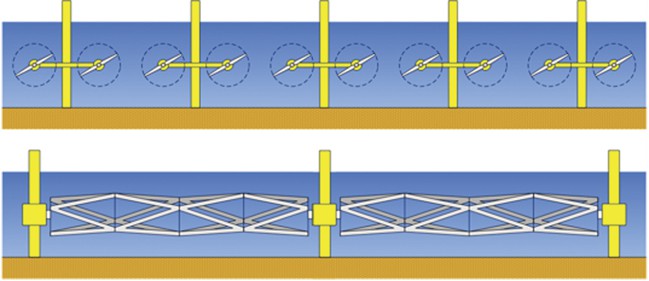
A key factor in the capacity of the generators is that when the area of the turbine is large compared with the flow of the water, the power output is proportional to the head – the difference in height between the top of the tidal flow and the turbine site – rather than the flow velocity. In other words, it extracts potential energy, as well as just kinetic energy, as is the case for conventional tidal turbines
Kepler has big plans for the technology, with a targeted project of a 1km-long fence in the Bristol Channel. With a projected cost of £143m, this fence would generate 30MW of power, Dixon claimed;
a longer fence, 10km long, would have output comparable to a small nuclear power station.” The Bristol Channel fence, which would run between Abertawe and Minehead, could be operational
by 2020-21, Dixon claimed.




Report highlights significant impact of manufacturing on UK economy
Note to Evil Villain/Dave 2020. Thatcher was PM for _11_ years, from 1979 to 1990 so no one under the age of 34 was even born when she left office....